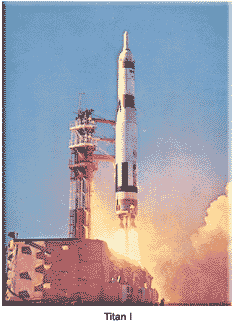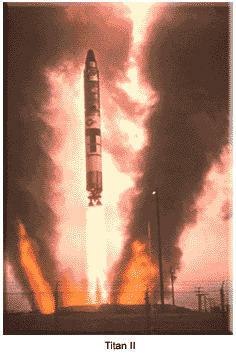The Titan ICBM was the second missile developed by the United States and the last liquid-propelled rocket to be deployed. Development of the Titan was undertaken at the same time that Project Atlas was made a priority in 1954, as an alternative in case the Atlas proved infeasible.
 The Titan was the first ICBM, or Inter-Continental Ballistic Missile, with two distinct stages of differing diameters. It was designed to be launched from a silo and deliver a Hydrogen Bomb to a target up to 10,000 kilometers (6214 miles) away. At a cost of $1.5 million a piece, two versions of the U.S. Air Force’s Titan were deployed. Titan 1 did not have the silo capability, so it was highly vulnerable to a first-strike attack by the Soviet Union.
Five contractors were used to produce them: Glenn L. Martin Aircraft Company (later Martin-Marietta) produced the airframe; Aerojet-General Company made the liquid-oxygen and kerosene-propulsion system; the Radio-inertial Guidance System was designed by Bell Telephone Laboratories; the Guidance Computer was made by Remington Rand UNIVAC; and AVCO Corporation crafted the re-entry vehicle.
It was also somewhat inaccurate, having a Circular Error Probable (CEP) radius of nearly a mile. This made it useful only for such large targets as population centers. The Titan 1 was first tested in 1959. Tests were completed in 1960 and the missile was deployed in 1961. It was removed from service in 1965, in favor of the Titan 2. Since retired Atlas missiles had already been retrofitted as launch vehicles, and there were no other demands for them, there was no use in keeping them. Approximately 20 missiles were provided to museums, and the remaining nearly 70 were scrapped in the early 1970s.
The Titan was the first ICBM, or Inter-Continental Ballistic Missile, with two distinct stages of differing diameters. It was designed to be launched from a silo and deliver a Hydrogen Bomb to a target up to 10,000 kilometers (6214 miles) away. At a cost of $1.5 million a piece, two versions of the U.S. Air Force’s Titan were deployed. Titan 1 did not have the silo capability, so it was highly vulnerable to a first-strike attack by the Soviet Union.
Five contractors were used to produce them: Glenn L. Martin Aircraft Company (later Martin-Marietta) produced the airframe; Aerojet-General Company made the liquid-oxygen and kerosene-propulsion system; the Radio-inertial Guidance System was designed by Bell Telephone Laboratories; the Guidance Computer was made by Remington Rand UNIVAC; and AVCO Corporation crafted the re-entry vehicle.
It was also somewhat inaccurate, having a Circular Error Probable (CEP) radius of nearly a mile. This made it useful only for such large targets as population centers. The Titan 1 was first tested in 1959. Tests were completed in 1960 and the missile was deployed in 1961. It was removed from service in 1965, in favor of the Titan 2. Since retired Atlas missiles had already been retrofitted as launch vehicles, and there were no other demands for them, there was no use in keeping them. Approximately 20 missiles were provided to museums, and the remaining nearly 70 were scrapped in the early 1970s.
 The Titan 2 was a significantly improved version. It could be launched from hardened silos that could withstand 100 psi of pressure, giving it the ability to survive a first attack. However, the missile had to be raised above ground by elevator prior to launch. It also had a much tighter CEP, which would have permitted its use against densely populated areas, or hardened targets. The Titan 2 remained in service until 1987, when it was deactivated under terms of arms-control treaties.
Titan missiles played a role in the 1961 Cuban Missile Crisis. Prior to the crisis, a squadron of Titans had been deployed in Turkey. To Soviet premier Nikita Khrushchev, this represented as great a threat to the Soviet Union as the Soviet missiles in Cuba did to the United States. A confidential criterion of the agreement that ended the crisis was that the United States would remove its missiles from Turkey within a short interval. This was accomplished later without any public acknowledgment that it had been part of the deal.
The Titan 2 was a significantly improved version. It could be launched from hardened silos that could withstand 100 psi of pressure, giving it the ability to survive a first attack. However, the missile had to be raised above ground by elevator prior to launch. It also had a much tighter CEP, which would have permitted its use against densely populated areas, or hardened targets. The Titan 2 remained in service until 1987, when it was deactivated under terms of arms-control treaties.
Titan missiles played a role in the 1961 Cuban Missile Crisis. Prior to the crisis, a squadron of Titans had been deployed in Turkey. To Soviet premier Nikita Khrushchev, this represented as great a threat to the Soviet Union as the Soviet missiles in Cuba did to the United States. A confidential criterion of the agreement that ended the crisis was that the United States would remove its missiles from Turkey within a short interval. This was accomplished later without any public acknowledgment that it had been part of the deal.